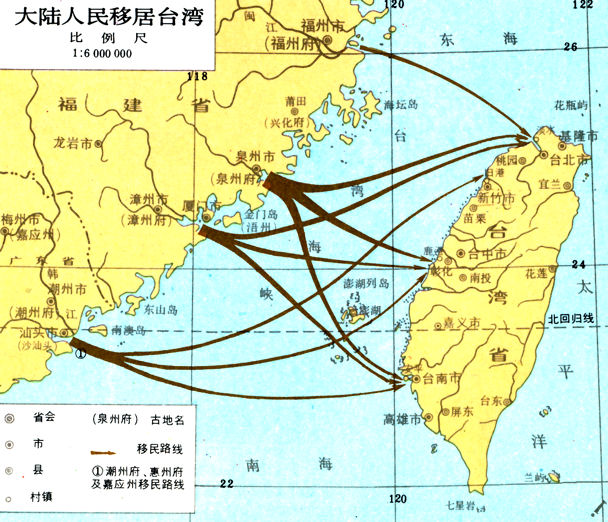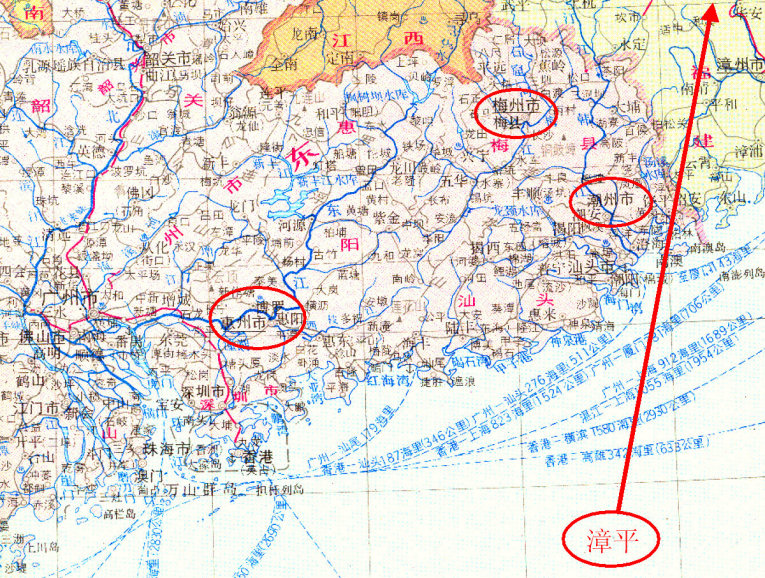
Content created: 2007-08-25
File last modified:

Internecine wars plagued Táiwān 臺灣 in the 1700s and 1800s among groups —sometimes called "ethnic" groups— associated with different places of origin in Fújiàn 福建 and Guǎngdōng 廣東 provinces.

The map at the right shows the mainland coast on the left and Taiwan on the right. Four waves of immigrants are shown with the width of the arrows in approximate proprotion to their numbers, originating (from north to south along the Fújiàn coast) at (1) Fúzhōu 福州, Quánzhōu 泉州 and Xiàmén 廈門, and (3) Zhāngzhōu 漳州 (in Fújiàn Province). The southernmost arrow (4) departs from Cháozhōu 潮州 (in Guǎngdōng Province), the embarcation point for many Hakka speakers.
Groups of immigrants often joined together in the worship of gods who had been important in their home districts on the mainland. When different immigrant groups allied with each other in Taiwan, these alliances also were thought to enjoy divine patronage. Although it may not be obvious to the casual visitor to a modern Taiwan temple, the deities enshrined there sometimes do (and sometimes do not) have associations with past alliances or competition. "Sub-ethnic" alliances among villages continue to be associated with divine patronage up to the present. An example is discussed in my book, Gods, Ghosts, & Ancestors, available free on this web site. (Link)
The following tables list towns in Fújiàn and Guǎngdōng whose emigrants in Táiwān tended to affiliate with each other, and the patron gods they typically selected. On the following map, different shapes and colors roughly correlate with different patron divinities. A separate page of this web site includes information on major Chinese dialects. (Link)

In general, immigrants into Taiwan from Fújiàn were loosely classifed into:
These terms reflected not merely the history of migration, but minor dialect differences as well, which, to a limited extent, can still be heard in Táiwān speech today.
The Zhāngzhōu 漳州, or (Lóngxī 龍溪) Alliance (red ovals on the map) included immigrants under the patronage of a god named Kāizhāng Shèngwáng 開彰聖王, including groups from towns located in the basin of the Jiǔlóng Jiāng 九龍江 river and its tributaries, as follows (reading upstream):
| Place in Fújiàn | Patron Divinity
|
|---|---|
| Jīnmén 金門 county | Kāizhāng Shèngwáng 開彰聖王 |
| Xiàmén 廈門 city | |
| Shímǎ 石碼鎮 zhèn (Lónghǎi xiàn 龍海縣) | |
| Lóngxī 龍溪 county (Zhāngzhōu 漳州 prefecture) | |
| Huá'ān 華盦 county | |
| Zhāngpíng 漳平 county |
The sligntly more fractious Quánzhōu 泉州 or (Jìnjiāng 晉江) Alliance (blue containers on the map) included immigrants from towns located in the basin of the Jìnjiāng 晉江 river and its tributaries, as follows:
| Place in Fújiàn | Patron Divinity |
|---|---|
| 1. "Sānyì" 三義 alliance (blue rectangles on map), consisting of: | Guǎngzé Zūnwáng 廣澤尊王 & Bǎoyí Dàifū 保儀大夫 |
| A. Jìnjiāng 晉江 county
(Quánzhōu 泉州 prefecture) | |
| B. Nán'ān 南安 county | Guǎngzé Zūnwáng 廣澤尊王 |
| C. Huì'ān 惠安 county | Líng'ān Zūnwáng 靈安尊王 (= Qīngshān Wáng 青山王) |
| 2. "Xiàjiāo" (厦郊?) alliance (blue ovals on map), consisting of: | |
| A. Ānxī 安息 county | Qīngshuǐ Zǔshī 清水祖師 & Bǎoyí Dàifū 保儀大夫 |
| B. Tóng'ān 同安 county | Bǎoyí Dàifū 保儀大夫 & Xiáhǎi Chénghuáng 霞海城隍 |
| 4. Déhuà 德化 county (northern triangle on map) | |
| 3. Yǒngchūn 永春 county (southern triangle on map) | |

Hakkas 客家 (speakers of Hakka, another major dialect of Chinese) were generally devotees of Sānshān Guówáng 三山國王 ("Kings of the Three Mountain Kingdoms" or "Three Kings of the Mountain Kingdom[s]"). Hakka in Taiwan today are also associated with the cult of the famous Táng 唐 dynasty official Hán Yù 韓愈, himself a Hakka (link). Taiwan Hakka migrated to the island from four main areas:
A scattering of other groups, apparently either composed of Hakkas or allied with Hakkas most of the time, traced their origins to a range of areas in Guǎngdōng and Fújiàn and occasionally elsewhere. They tended to be devotees of Guānyīn Púsà 觀音菩薩 when they sought a "neutral," pan-Chinese patron divinity to reign over their alliances.
The goddess Māzǔ 媽祖 (more formally known as Tiānshàng Shèngmǔ 天上聖母 or Tiānhòu 天后) also played a cross-group role in some cases, although she was less likely than Guānyīn to be perceived as pan-Chinese, and she was sometimes appropriated as the patron of particular ethnic sub-groups. (Today, although she is worshipped elsewhere as well, she is often considered to be the patron of Taiwan as a whole.)
Maps on this page are based on: